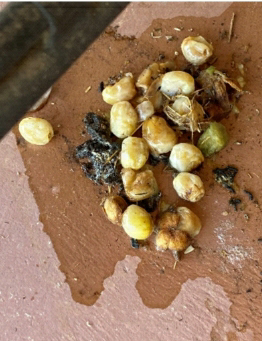Scientists have long been using scat as a valuable tool in figuring out what animals have eaten. The indigestible parts pass through and are excreted. Some items can be easily identified, but others require a bit of investigation.
 When the temperatures were warm enough, I let my sulcata, or spur-thigh, tortoise loose in my walled-in backyard. With the drought, my vegetation is rather sparse. I provide food for her, but she likes to forage on her own, too. She’d eaten all the aloe, munched on the prickly pear cactus pads, and gobbled up Texas olives (many of which came through intact.).
When the temperatures were warm enough, I let my sulcata, or spur-thigh, tortoise loose in my walled-in backyard. With the drought, my vegetation is rather sparse. I provide food for her, but she likes to forage on her own, too. She’d eaten all the aloe, munched on the prickly pear cactus pads, and gobbled up Texas olives (many of which came through intact.).
However, she recently left this deposit for me which had me perplexed.
I searched my yard and I think I finally found what she had been eating that wasn’t digested fully.
 I suspect the fibrous material is from the main stem of this large prickly pear cactus! She really should stick with eating the soft, juicy young pads.
I suspect the fibrous material is from the main stem of this large prickly pear cactus! She really should stick with eating the soft, juicy young pads.
Book Note: My publisher, Lyric Power Publishing LLC, publishes workbooks and activity sheets to go with my rhyming stories and adventure tales. If your children love hands-on coloring pages and solving problems, cutting and pasting, labeling the animal parts, learning the life cycles, and so on, they would love LPP’s fun, 40+ pages, comprehensive, yet economical workbooks. Click on the tortoise covers below to see what is in these workbooks all about tortoises, at the different grade levels.
Check them all out here.
#elaineapowers
#lyricpower
#sulcatatortoise
#spurthightortoise
#pricklypearcactus


